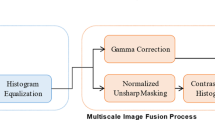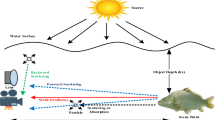Abstract
The clarity of algal images is crucial for solving problems such as harmful algal blooms (HABs) classification and red tide warning. However, the original underwater microscopic images of HABs often produce color distortion and blurred details due to the effects of seawater quality, illumination and image extraction techniques. To deal with the above problems, an enhancement computing method based on cyclic color compensation and three-image Multi-scale fusion is proposed in this paper. In this method, first, we propose a novel cyclic color compensation method to correct the color of the microscopic images of HABs. Then, with the input of three images derived from the color compensation versions of the original images of the algae, the correlation weight maps of the three inputs are redefined to facilitate the transfer of texture features and color contrast to the output images. Finally, to avoid image artifacts in the low-frequency components of the output image after the weight map transformation, a novel image Multi-scale fusion strategy is used in this paper. Qualitative and quantitative experimental results show that the underwater microscopic images of HABs enhanced with the method proposed in this paper have the best texture clarity and global contrast, and the method significantly improves the accuracy of transmission map estimation, edge detection and key point matching in processing algal images.













Similar content being viewed by others
Data availability
The datasets generated during and/or analysed during the current study are available from the corresponding author on reasonable request.
References
Aggarwal AK, Jaidka P (2022) Segmentation of crop images for crop yield prediction. Int J Biol Biomed 7
Aguirre-Castro OA, García-Guerrero EE, López-Bonilla OR, Tlelo-Cuautle E, López-Mancilla D, Cárdenas-Valdez JR, ... Inzunza-González E (2022) Evaluation of underwater image enhancement algorithms based on Retinex and its implementation on embedded systems. Neurocomputing 494:148–159
Agusa Y, Endo K, Kuroda H, Kobayashi S (2021) Examination of water temperature interpolation method for prediction. In: Progress in image processing, pattern recognition and communication systems. Springer, Cham, pp 339–350
Akkaynak D, Treibitz T (2019) Sea-thru: a method for removing water from underwater images. In: Proceedings of the IEEE/CVF conference on computer vision and pattern recognition, pp 1682–1691
Ancuti CO, Ancuti C, De Vleeschouwer C, Bekaert P (2017) Color balance and fusion for underwater image enhancement. IEEE Trans Image Process 27(1):379–393
Arora K, Aggarwal AK (2018) Approaches for image database retrieval based on color, texture, and shape features. In: Handbook of research on advanced concepts in real-time image and video processing. IGI Global, pp 28–50
Azmi KZM, Ghani ASA, Yusof ZM, Ibrahim Z (2019) Natural-based underwater image color enhancement through fusion of swarm-intelligence algorithm. Appl Soft Comput 85:105810
Daway HG, Daway EG (2019) Underwater image enhancement using colour restoration based on YCbCr colour model. In: IOP conference series: materials science and engineering (vol 571, no 1, p. 012125). IOP Publishing
Emberton S, Chittka L, Cavallaro A (2018) Underwater image and video dehazing with pure haze region segmentation. Comput Vis Image Underst 168:145–156
Finlayson GD, Trezzi E (2004) Shades of gray and colour constancy. In: Color and imaging conference vol. 2004, no. 1. Society for Imaging Science and Technology, pp 37–41
Galdran A, Pardo D, Picón A, Alvarez-Gila A (2015) Automatic red-channel underwater image restoration. J Vis Commun Image Represent 26:132–145
Gao SB, Zhang M, Zhao Q, Zhang XS, Li YJ (2019) Underwater image enhancement using adaptive retinal mechanisms. IEEE Trans Image Process 28(11):5580–5595
He J, Zhang S, Yang M, Shan Y, Huang T (2019) Bi-directional cascade network for perceptual edge detection. In: Proceedings of the IEEE/CVF conference on computer vision and pattern recognition, pp 3828–3837
Huang D, Wang Y, Song W, Sequeira J, Mavromatis S (2018) Shallow-water image enhancement using relative global histogram stretching based on adaptive parameter acquisition. In: International conference on multimedia modeling. Springer, Cham, pp 453–465
Huang R, Yu K, Huang X, Zou W, Wang Y (2019) Combining Landsat images with historic records to estimate the live coral cover of Luhuitou fringing reef in northern South China Sea. Image Vis Comput 92:103812
Huo F, Li B, Zhu X (2021) Efficient wavelet boost learning-based multi-stage progressive refinement network for underwater image enhancement. In: Proceedings of the IEEE/CVF international conference on computer vision, pp 1944–1952
Hussain MA, Akbari AS (2016) Max-RGB based colour constancy using the sub-blocks of the image. In: 2016 9th international conference on developments in eSystems engineering (DeSE). IEEE, pp 289–294
Kumari T, Guleria V, Syal P, Aggarwal AK (2021) A feature cum intensity based SSIM optimised hybrid image registration technique. In: 2021 international conference on computing, communication and green engineering (CCGE). IEEE, pp 1–8
Lee MS, Park KA, Chae J, Park JE, Lee JS, Lee JH (2020) Red tide detection using deep learning and high-spatial resolution optical satellite imagery. Int J Remote Sens 41(15):5838–5860
Lee MS, Park KA, Micheli F (2021) Derivation of red tide index and density using geostationary ocean color imager (GOCI) data. Remote Sens 13(2):298
Li Y, Lu H, Li J, Li X, Li Y, Serikawa S (2016) Underwater image de-scattering and classification by deep neural network. Comput Electr Eng 54:68–77
Li M, Liu J, Yang W, Sun X, Guo Z (2018) Structure-revealing low-light image enhancement via robust retinex model. IEEE Trans Image Process 27(6):2828–2841
Li Y, Zhang Y, Xu X, He L, Serikawa S, Kim H (2019) Dust removal from high turbid underwater images using convolutional neural networks. Opt Laser Technol 110:2–6
Li C, Anwar S, Hou J, Cong R, Guo C, Ren W (2021) Underwater image enhancement via medium transmission-guided multi-color space embedding. IEEE Trans Image Process 30:4985–5000
Liu Y, Rong S, Cao X, Li T, He B (2020) Underwater single image dehazing using the color space dimensionality reduction prior. IEEE Access 8:91116–91128
Lu H, Li Y, Zhang Y, Chen M, Serikawa S, Kim H (2017) Underwater optical image processing: a comprehensive review. Mob Netw Appl 22(6):1204–1211
Lu J, Li N, Zhang S, Yu Z, Zheng H, Zheng B (2019) Multi-scale adversarial network for underwater image restoration. Opt Laser Technol 110:105–113
Luchman S, Viriri S (2021) Underwater image enhancement using adaptive algorithms. In: International workshop on artificial intelligence and pattern recognition. Springer, Cham, pp 316–326
Ma X, Chen Z, Feng Z (2019) Underwater image restoration through a combination of improved dark channel prior and gray world algorithms. J Electronic Imaging 28(5):053033–053033
Malik S, Kumar T (2016) Comparative analysis of edge detection between gray scale and color image. Communications on Applied Electronics (CAE)–ISSN, 2394–4714
Matos F, Menkovski V, Felici F, Pau A, Jenko F, TCV Team, & EUROfusion MST1 Team (2020) Classification of tokamak plasma confinement states with convolutional recurrent neural networks. Nuclear Fusion 60(3):036022
Muniraj M, Dhandapani V (2021) Underwater image enhancement by combining color constancy and dehazing based on depth estimation. Neurocomputing 460:211–230
Poma XS, Riba E, Sappa A (2020) Dense extreme inception network: towards a robust cnn model for edge detection. In: Proceedings of the IEEE/CVF winter conference on applications of computer vision, pp 1923–1932
Raveendran S, Patil MD, Birajdar GK (2021) Underwater image enhancement: a comprehensive review, recent trends, challenges and applications. Artif Intell Rev 54(7):5413–5467
Sahu S, Singh AK, Ghrera SP, Elhoseny M (2019) An approach for de-noising and contrast enhancement of retinal fundus image using CLAHE. Opt Laser Technol 110:87–98
Saleh A, Sheaves M, Jerry D, Azghadi MR (2022) Adaptive uncertainty distribution in deep learning for unsupervised underwater image enhancement. arXiv preprint arXiv:2212.08983
Shi D, Ma L, Liu R, Fan X, Luo Z (2021) Semantic-driven context aggregation network for underwater image enhancement. In: Chinese conference on pattern recognition and computer vision (PRCV). Springer, Cham, pp 29–40
Song W, Wang Y, Huang D, Tjondronegoro D (2018) A rapid scene depth estimation model based on underwater light attenuation prior for underwater image restoration. In: Pacific rim conference on multimedia. Springer, Cham, pp 678–688
Thukral R, Kumar A, Arora AS (2019) Effect of different thresholding techniques for denoising of emg signals by using different wavelets. In: 2019 2nd international conference on intelligent communication and computational techniques (ICCT). IEEE, pp 161–165
Thukral R, Arora AS, Kumar A (2022) Denoising of thermal images using deep neural network. In: Proceedings of international conference on recent trends in computing: ICRTC 2021. Springer Nature Singapore, Singapore, pp 827–833
Yang M, Hu K, Du Y, Wei Z, Sheng Z, Hu J (2020) Underwater image enhancement based on conditional generative adversarial network. Signal Process Image Commun 81:115723
Acknowledgments
The authors are grateful for the collaborative funding support from the Shandong Natural Science Foundation of China (ZR2021MD063).
Funding
This work was supported by Shandong Natural Science Foundation of China (ZR2021MD063).
Author information
Authors and Affiliations
Corresponding author
Additional information
Publisher’s note
Springer Nature remains neutral with regard to jurisdictional claims in published maps and institutional affiliations.
Rights and permissions
Springer Nature or its licensor (e.g. a society or other partner) holds exclusive rights to this article under a publishing agreement with the author(s) or other rightsholder(s); author self-archiving of the accepted manuscript version of this article is solely governed by the terms of such publishing agreement and applicable law.
About this article
Cite this article
Wu, GK., Xu, J., Zhang, YD. et al. Underwater enhancement computing of ocean HABs based on cyclic color compensation and multi-scale fusion. Multimed Tools Appl 83, 16657–16681 (2024). https://doi.org/10.1007/s11042-023-16258-0
Received:
Revised:
Accepted:
Published:
Issue Date:
DOI: https://doi.org/10.1007/s11042-023-16258-0




